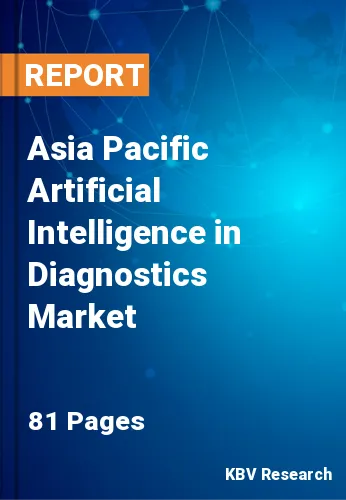The Asia Pacific Artificial Intelligence in Diagnostics Market would witness market growth of 29.2% CAGR during the forecast period (2020-2026). There are already a number of research studies suggesting that AI can perform key health care tasks, such as the diagnosis of disease, as well as or better than humans. Algorithms are now outperforming radiologists in identifying malignant tumours and leading researchers on how to build samples for expensive clinical trials. However, for a number of reasons, we agree that it will be several years before AI substitutes humans across a wide range of medical processes. In this essay, we discuss both the ability of AI to simplify aspects of treatment and some of the obstacles to the rapid introduction of AI in healthcare.
While early attempts to provide diagnosis and care advice have proven difficult, we expect AI to ultimately master this domain as well. Considering the rapid advances in AI for imaging research, it appears likely that most images in radiology and pathology will be analysed by a computer at some point in time. Speech and text recognition have also been used for activities such as patient care and documentation of clinical records, and their use will increase.
The biggest obstacle for AI in these health-care environments is not that innovations can be capable of being effective enough, but instead to ensure that they are implemented in everyday clinical practice. In order for widespread implementation to take place, AI systems must be accepted by regulators, incorporated with EHR systems, adequately standardized to ensure that similar products function in a similar manner, taught to clinicians, paid for by public or private payer organizations, and modified in the field over time. At the end of the day, these challenges will be overcome, but they will take much longer to do so than the technologies themselves will need to mature.
Machine learning has revolutionized our way of life, from language recognition, image processing, handwriting, weather forecasts, and GPS to online search engines. It is now time to focus on successes in machine learning for biological discovery to the benefit of human health. Artificial Intelligence is a subset of computer science that has the ability to interpret complex data. Their potential is to create a consistent relationship with the data collection which can be used in many clinical settings for diagnosis, a treatment which predictive outcomes.
Based on Diagnosis Type, the market is segmented into Radiology, Oncology, Neurology, Cardiology, Chest & Lungs, Pathology and Other Diagnosis Types. Based on Component, the market is segmented into Services, Software and Hardware. Based on countries, the market is segmented into China, Japan, India, South Korea, Singapore, Malaysia, and Rest of Asia Pacific.
Free Valuable Insights: Artificial Intelligence in Diagnostics Market in Asia Pacific is expected to register a CAGR of 29.2% during the forecast period (2020-2026)
The market research report covers theanalysis of key stake holders of the market. Key companies profiled in the report include General Electric (GE) Co. (GE Healthcare), Siemens AG (Siemens Healthineers), Aidoc Medical Ltd., AliveCor, Inc., Imagen Technologies, Inc., VUNO, Inc., IDx Technologies, Inc., NovaSignal Corporation, Riverain Technologies, LLC, and Zebra Medical Vision Ltd.
Market Segmentation:
By Diagnosis Type
By Component
By Country
Companies Profiled
Our team of dedicated experts can provide you with attractive expansion opportunities for your business.

